Desa FDCFTP, VDCFTN, FDCFTN, CDCFTP, FDCFRP User Manual
...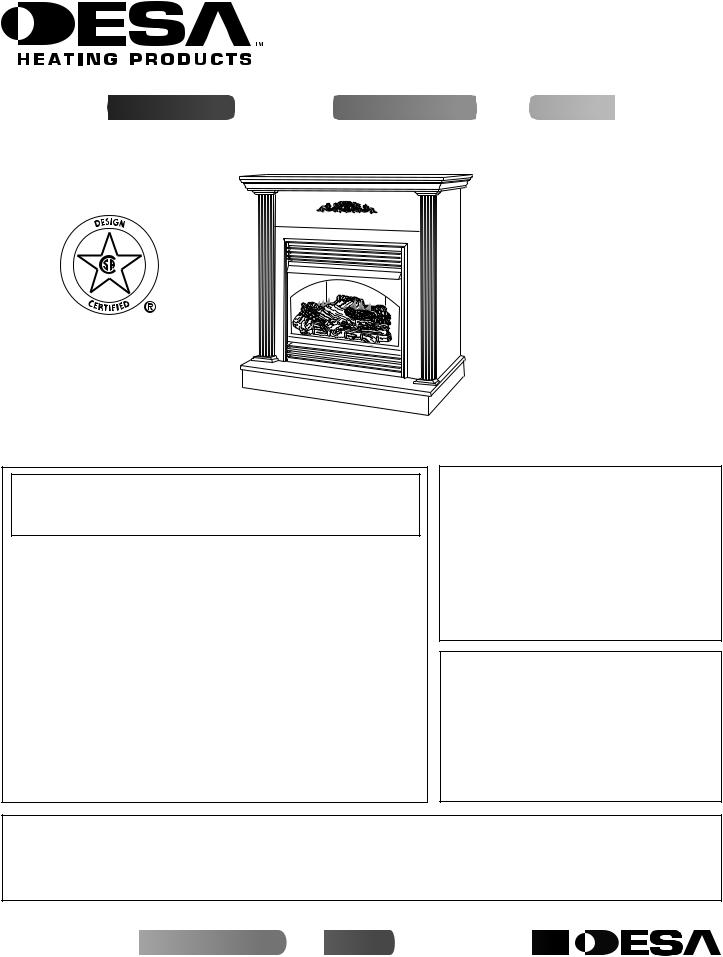
UNVENTED (VENT-FREE) GAS
COMPACT CLASSIC HEARTH®
DUAL BURNER FIREPLACE
OWNER’S OPERATION AND INSTALLATION MANUAL



 For more
For more


 visit www.
visit www.

 .com
.com



Shown with Optional
Cabinet Mantel/Hearth
Base Accessory
WARNING: If the information in this manual is not followed exactly, a fire or explosion may result causing property damage, personal injury, or loss of life.
—Do not store or use gasoline or other flammable vapors and liquids in the vicinity of this or any other appliance.
—WHAT TO DO IF YOU SMELL GAS
•Do not try to light any appliance.
•Do not touch any electrical switch; do not use any phone in your building.
•Immediately call your gas supplier from a neighbor’s phone. Follow the gas supplier’s instructions.
•If you cannot reach your gas supplier, call the fire department.
—Installation and service must be performed by a qualified installer, service agency, or the gas supplier.
Thermostat Models:
CDCFTN, CDCFTP,
VDCFTN, VDCFTP,
FDCFTN, FDCFTP
Remote-Ready Models:
VDCFRN, VDCFRP,
FDCFRN, FDCFRP
WARNING: Improper installation, adjustment, alteration, service, or maintenance can cause injury or property damage. Refer to this manual for correct installation and operational procedures. For assistance or additional information consult a qualified installer, service agency, or the gas supplier.
WARNING: This is an unvented gasfired heater. It uses air (oxygen) from the room in which it is installed. Provisions for adequate combustion and ventilation air must be provided. Refer to Air for Combustion and Ventilation section on page 5 of this manual.
This appliance may be installed in an aftermarket,* permanently located, manufactured (mobile) home, where not prohibited by local codes.
This appliance is only for use with the type of gas indicated on the rating plate. This appliance is not convertible for use with other gases.
* Aftermarket: Completion of sale, not for purpose of resale, from the manufacturer



 Save this
Save this
 for
for





 .
.
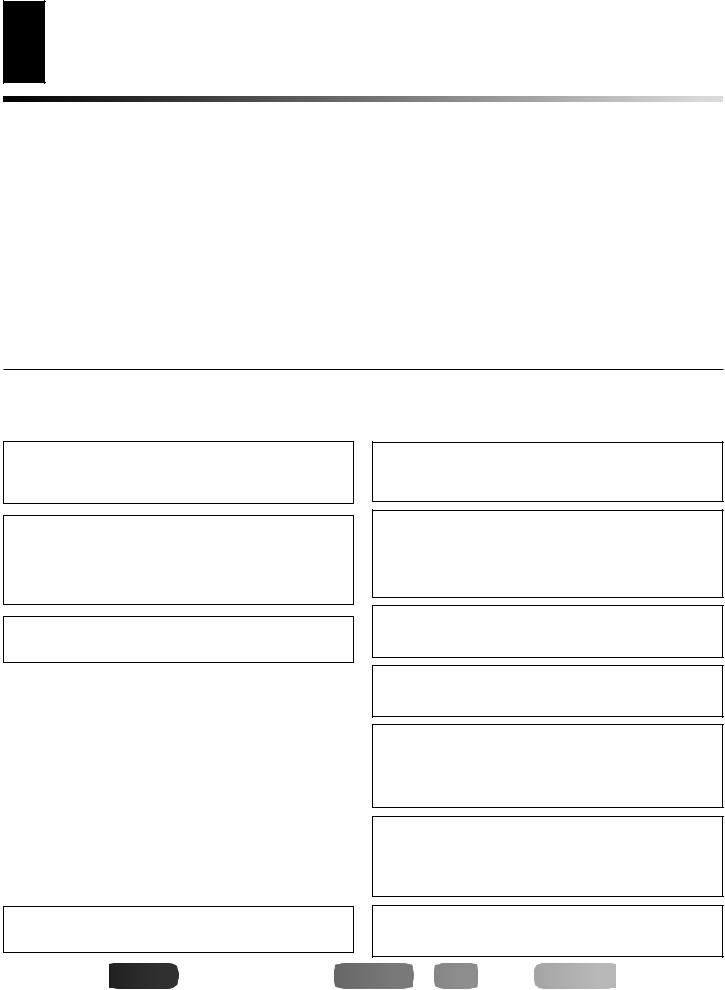
TABLE OF CONTENTS 2 SAFETY INFORMATION
TABLE OF CONTENTS |
|
SAFETY INFORMATION ............................................................ |
2 |
PRODUCT IDENTIFICATION ..................................................... |
3 |
OPTIONAL REMOTE CONTROL ACCESSORIES .................... |
4 |
LOCAL CODES ........................................................................... |
4 |
PRODUCT FEATURES .............................................................. |
4 |
UNPACKING ............................................................................... |
4 |
HOOD ASSEMBLY ..................................................................... |
4 |
AIR FOR COMBUSTION AND VENTILATION ........................... |
5 |
INSTALLATION ........................................................................... |
7 |
OPERATING FIREPLACE ........................................................ |
19 |
INSPECTING BURNERS.......................................................... |
24 |
CLEANING AND MAINTENANCE ............................................ |
24 |
WIRING DIAGRAM ................................................................... |
25 |
TROUBLESHOOTING .............................................................. |
26 |
SPECIFICATIONS .................................................................... |
29 |
SERVICE HINTS ....................................................................... |
29 |
TECHNICAL SERVICE ............................................................. |
29 |
REPLACEMENT PARTS .......................................................... |
29 |
ILLUSTRATED PARTS BREAKDOWN AND PARTS LIST ....... |
30 |
ACCESSORIES ........................................................................ |
36 |
OWNER’S REGISTRATION FORM .......................................... |
39 |
SAFETY INFORMATION
 WARNINGS
WARNINGS
 WARNING: This product contains and/or generates chemicals known to the State of California to cause cancer or birth defects, or other reproductive harm.
WARNING: This product contains and/or generates chemicals known to the State of California to cause cancer or birth defects, or other reproductive harm.
IMPORTANT: Read this owner’s manual carefully and completely before trying to assemble, operate, or service this fireplace. Improper use of this fireplace can cause serious injury or death from burns, fire, explosion, electrical shock, and carbon monoxide poisoning.
 DANGER: Carbon monoxide poisoning may lead to death!
DANGER: Carbon monoxide poisoning may lead to death!
Carbon Monoxide Poisoning: Early signs of carbon monoxide poisoning resemble the flu, with headaches, dizziness, or nausea. If you have these signs, the fireplace may not be working properly. Get fresh air at once! Have fireplace serviced. Some people are more affected by carbon monoxide than others. These include pregnant women, people with heart or lung disease or anemia, those under the influence of alcohol, and those at high altitudes.
Natural and Propane/LP Gas: Natural and propane/LP gases are odorless. An odor-making agent is added to the gas. The odor helps you detect a gas leak. However, the odor added to the gas can fade. Gas may be present even though no odor exists.
Make certain you read and understand all warnings. Keep this manual for reference. It is your guide to safe and proper operation of this fireplace.
 WARNING: Any change to this fireplace or its controls can be dangerous.
WARNING: Any change to this fireplace or its controls can be dangerous.
 WARNING: Do not use a blower insert, heat exchanger insert, or other accessory not approved for use with this fireplace.
WARNING: Do not use a blower insert, heat exchanger insert, or other accessory not approved for use with this fireplace.
 WARNING: Do not allow fans to blow directly into the fireplace. Avoid any drafts that alter burner flame patterns. Ceiling fans can create drafts that alter burner flame patterns. Altered burner patterns can cause sooting.
WARNING: Do not allow fans to blow directly into the fireplace. Avoid any drafts that alter burner flame patterns. Ceiling fans can create drafts that alter burner flame patterns. Altered burner patterns can cause sooting.
Due to high temperatures, the appliance should be located out of traffic and away from furniture and draperies.
Do not place clothing or other flammable material on or near the appliance. Never place any objects on the heater.
Fireplace front and screen become very hot when running heater. Keep children and adults away from hot surfaces to avoid burns or clothing ignition. Fireplace will remain hot for a time after shutdown. Allow surfaces to cool before touching.
Carefully supervise young children when they are in the room with fireplace. When using the hand-held remote accessory (Remote-Ready Models Only), keep selector switch in the OFF position to prevent children from turning on burners with remote.
You must operate this fireplace with the fireplace screen in place. Make sure fireplace screen is closed before running fireplace.




 For
For





 visit
visit
 .
.

 .com
.com




111244-01A
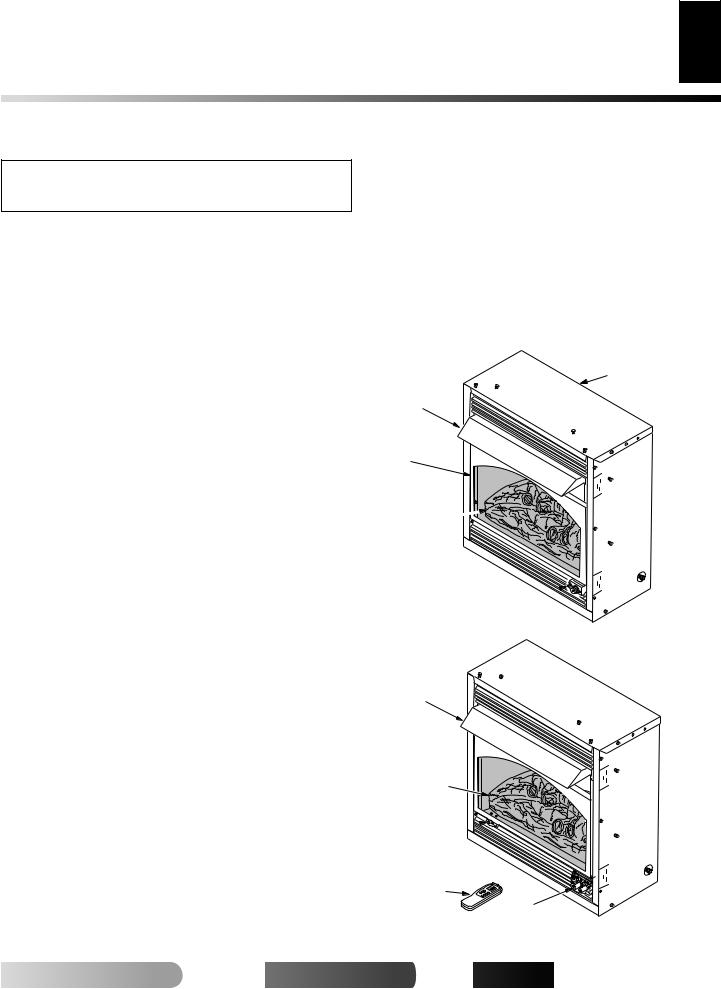
SAFETY INFORMATION |
3 |
PRODUCT IDENTIFICATION |
SAFETY INFORMATION
Continued
Keep the appliance area clear and free from combustible materials, gasoline, and other flammable vapors and liquids.
1.This appliance is only for use with the type of gas indicated on the rating plate. This appliance is not convertible for use with other gases.
2.Do not place propane/LP supply tank(s) inside any structure. Locate propane/LP supply tank(s) outdoors.
3.If you smell gas
•shut off gas supply
•do not try to light any appliance
•do not touch any electrical switch; do not use any phone in your building
•immediately call your gas supplier from a neighbor’s phone. Follow the gas supplier’s instructions
•if you cannot reach your gas supplier, call the fire department
4.This fireplace shall not be installed in a bathroom. RemoteReady Models shall not be installed in a bedroom.
5.Do not use this fireplace as a wood-burning fireplace. Use only the logs provided with the fireplace.
6.Do not add extra logs or ornaments such as pine cones, vermiculite, or rock wool. Using these added items can cause sooting. Do not add lava rock around base. Rock and debris could fall into the control area of fireplace.
7.This fireplace is designed to be smokeless. If logs ever appear to smoke, turn off fireplace and call a qualified service person. Note: During initial operation, slight smoking could occur due to log curing and fireplace burning manufacturing residues.
8.To prevent the creation of soot, follow the instructions in Cleaning and Maintenance, pages 24 and 25.
9.Before using furniture polish, wax, carpet cleaner, or similar products, turn fireplace off. If heated, the vapors from these products may create a white powder residue within burner box or on adjacent walls or furniture.
10.This fireplace needs fresh air ventilation to run properly. This fireplace has an Oxygen Depletion Sensing (ODS) safety shutoff system. The ODS shuts down the fireplace if not enough fresh air is available. See Air for Combustion and Ventilation, pages 5 through 7. If fireplace keeps shutting off, see Troubleshooting, pages 26 through 28.
11.Do not run fireplace
•where flammable liquids or vapors are used or stored.
•under dusty conditions.
12.Do not use this fireplace to cook food or burn paper or other objects.
13.Never place any objects in the fireplace or on logs.
14.Do not use fireplace if any part has been under water. Immediately call a qualified service technician to inspect the room fireplace and to replace any part of the control system and any gas control which has been under water.
15.Turn off and unplug fireplace and let cool before servicing. Only a qualified service person should service and repair fireplace.
16.Operating fireplace above elevations of 4,500 feet could cause pilot outage.
17.Do not operate fireplace if log is broken. Do not operate fireplace if log is chipped (dime-sized or larger).
18.To prevent performance problems, do not use propane/LP fuel tank of less than 100 lbs. capacity.
19.Provide adequate clearances around air openings.
PRODUCT IDENTIFICATION
Fireplace
Cabinet
Hood
Screen
Log 


Ignitor Button 

Control Knob
Fireplace
 Cabinet
Cabinet
Hood
Logs
Ignitor Button 
Remote |
|
|
Control |
Control |
|
(Optional) |
||
Knob |
||
|
Figure 1 - Vent-Free Compact Dual Flame Fireplace
For more

 visit www.
visit www.

 .com
.com



111244-01A
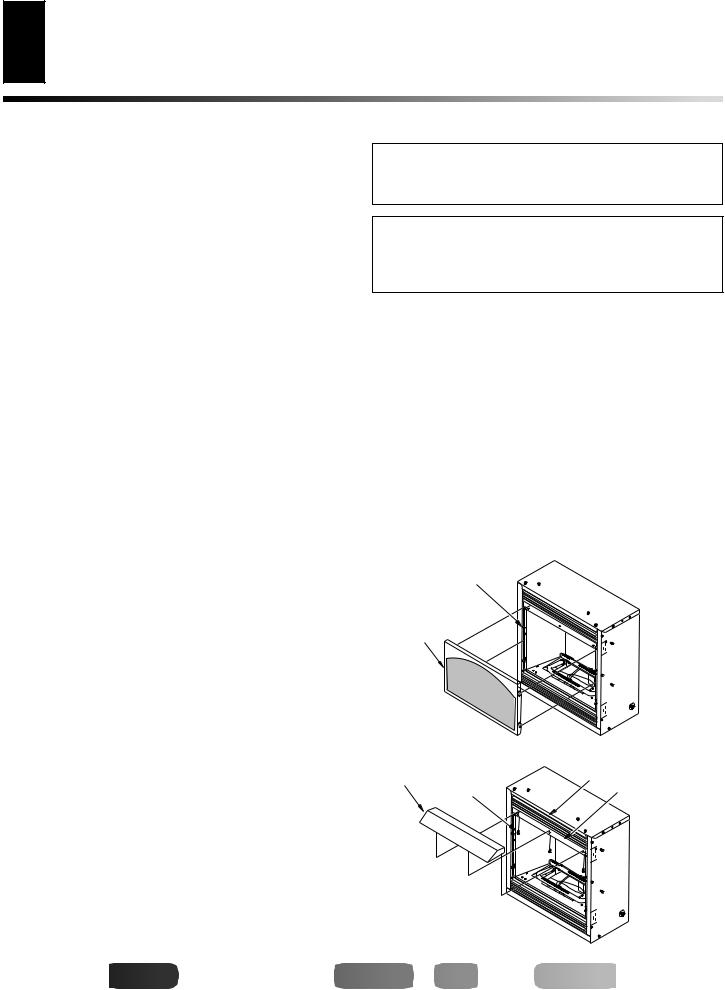
OPTIONAL REMOTE CONTROL ACCESSORIES 4 LOCAL CODES
PRODUCT FEATURES UNPACKING
HOOD ASSEMBLY
OPTIONAL REMOTE CONTROL ACCESSORIES
(For Remote-Ready Models Only)
There are four optional remote controls that can be purchased separately for Remote-Ready Models only:
• |
wall switch |
• |
hand-held ON/OFF remote |
• |
wall thermostat |
• |
hand-held thermostat remote |
See Accessories, pages 36 and 37.
LOCAL CODES
Install and use fireplace with care. Follow all local codes. In the absence of local codes, use the latest edition of The National Fuel Gas Code ANSI Z223.1/NFPA 54*.
*Available from:
American National Standards Institute, Inc.
1430 Broadway
New York, NY 10018
National Fire Protection Association, Inc.
Batterymarch Park
Quincy, MA 02269
PRODUCT FEATURES
SAFETY PILOT
This fireplace has a pilot with an Oxygen Depletion Sensing (ODS) safety shutoff system. The ODS/pilot is a required feature for vent-free room fireplaces. The ODS/pilot shuts off the fireplace if there is not enough fresh air.
PIEZO IGNITION SYSTEM
This fireplace has a piezo ignitor. This system requires no matches, batteries, or other sources to light fireplace.
THERMOSTATIC HEAT CONTROL FOR THERMOSTAT-CONTROLLED MODELS
Thermostat-Controlled models have a thermostat sensing bulb and a control valve. The thermostat will automatically modulate the heat output to maintain a consistent room temperature. This results in greater fireplace comfort. This can also result in lower gas bills.
UNPACKING
1.Remove fireplace and hood from carton. Log is wrapped and inside fireplace. Do not remove at this time.
2.Remove all protective packaging applied to fireplace for shipment.
3.Make sure your fireplace includes one hardware packet.
4.Check fireplace for any shipping damage. If fireplace is damaged, promptly inform dealer where you bought fireplace.
HOOD ASSEMBLY
 WARNING: Always have screen in place before operating fireplace. This prevents excessive temperatures on fireplace surfaces.
WARNING: Always have screen in place before operating fireplace. This prevents excessive temperatures on fireplace surfaces.
 WARNING: Failure to position the parts in accordance with these diagrams or failure to use only parts specifically approved with this fireplace may result in property damage or personal injury.
WARNING: Failure to position the parts in accordance with these diagrams or failure to use only parts specifically approved with this fireplace may result in property damage or personal injury.
Tools Required: |
|
|
|
• |
Phillips screwdriver |
• |
slotted screwdriver |
• |
5/16" hex wrench |
• |
scissors |
1.Lift fireplace screen up and pull out to remove (see Figure 2). Set screen aside until installation has been completed.
2.Cut two plastic straps to remove the log from the firebox cavity. Set log aside.
3.An optional blower is available. See Accessories, pages 36 and 37. Install optional blower now. Follow installation instructions provided with blower and see page 12 for Remote-Ready Models or page 13 for Thermostat-Controlled Models.
4.Locate four black phillips sheet metal screws in hardware packet.
5.Slide hood between louver and firebox top and align screw holes.
6.Insert screws as shown in Figure 3. Tighten screws firmly.
Shoulder Screw
Screen
Figure 2 - Removing and Installing Screen
Hood |
Sheet Metal |
Louver |
|
Screws |
Firebox Top |
Figure 3 - Assembling Hood




 For
For





 visit
visit
 .
.

 .com
.com




111244-01A
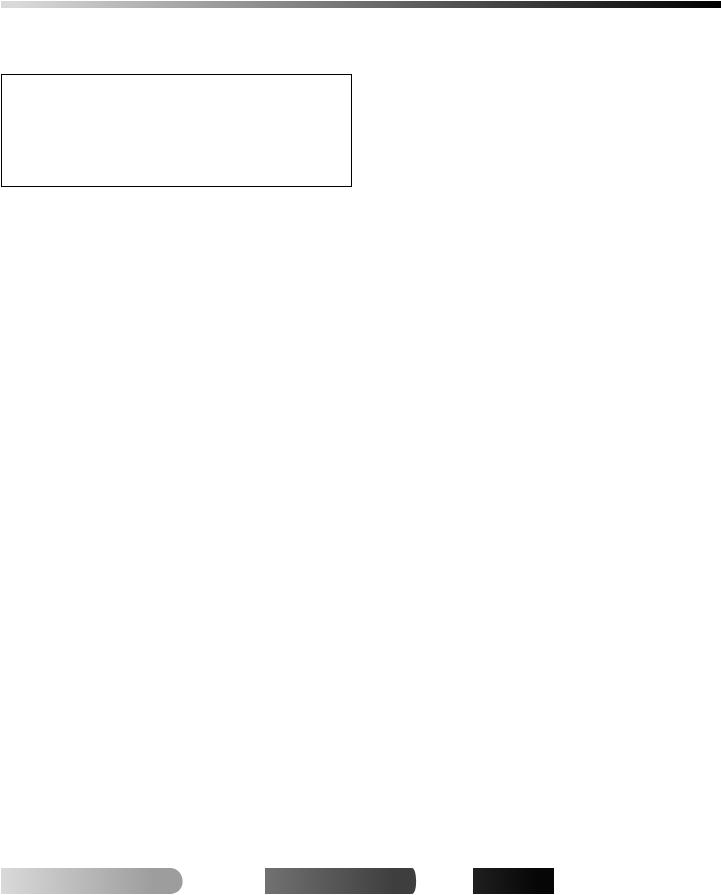
AIR FOR COMBUSTION AND VENTILATION |
5 |
Providing Adequate Ventilation |
|
Determining Fresh-Air Flow for Fireplace Location |
|
|
|
AIR FOR COMBUSTION AND
VENTILATION
 WARNING: This fireplace shall not be installed in a confined space or unusually tight construction unless provisions are provided for adequate combustion and ventilation air. Read the following instructions to insure proper fresh air for this and other fuel-burning appliances in your home.
WARNING: This fireplace shall not be installed in a confined space or unusually tight construction unless provisions are provided for adequate combustion and ventilation air. Read the following instructions to insure proper fresh air for this and other fuel-burning appliances in your home.
Today’s homes are built more energy efficient than ever. New materials, increased insulation, and new construction methods help reduce heat loss in homes. Home owners weather strip and caulk around windows and doors to keep the cold air out and the warm air in. During heating months, home owners want their homes as airtight as possible.
While it is good to make your home energy efficient, your home needs to breathe. Fresh air must enter your home. All fuel-burning appliances need fresh air for proper combustion and ventilation.
Exhaust fans, fireplaces, clothes dryers, and fuel burning appliances draw air from the house to operate. You must provide adequate fresh air for these appliances. This will insure proper venting of vented fuel-burning appliances.
PROVIDING ADEQUATE VENTILATION
The following are excerpts from National Fuel Gas Code, ANSI Z223.1/NFPA 54, Section 5.3, Air for Combustion and Ventilation.
All spaces in homes fall into one of the three following ventilation classifications:
1.Unusually Tight Construction
2.Unconfined Space
3.Confined Space
The information on pages 5 through 7 will help you classify your space and provide adequate ventilation.
Unusually Tight Construction
The air that leaks around doors and windows may provide enough fresh air for combustion and ventilation. However, in buildings of unusually tight construction, you must provide additional fresh air.
Unusually tight construction is defined as construction where:
a.walls and ceilings exposed to the outside atmosphere have a continuous water vapor retarder with a rating of one perm (6 x 10-11 kg per pa-sec-m2) or less with openings gasketed or sealed and
b.weather stripping has been added on openable windows and doors and
c.caulking or sealants are applied to areas such as joints around window and door frames, between sole plates and floors, between wall-ceiling joints, between wall panels, at penetrations for plumbing, electrical, and gas lines, and at other openings.
If your home meets all of these three criteria, you must provide additional fresh air. See Ventilation Air From Outdoors, page 8.
If your home does not meet all of the three criteria above, proceed to Determining Fresh-Air Flow For Fireplace Location, below.
Confined and Unconfined Space
The National Fuel Gas Code, ANSI Z223.1/NFPA 54 defines a confined space as a space whose volume is less than 50 cubic feet per 1,000 Btu per hour (4.8 m3 per kw) of the aggregate input rating of all appliances installed in that space and an unconfined space as a space whose volume is not less than 50 cubic feet per 1,000 Btu per hour (4.8 m3 per kw) of the aggregate input rating of all appliances installed in that space. Rooms communicating directly with the space in which the appliances are installed*, through openings not furnished with doors, are considered a part of the unconfined space.
* Adjoining rooms are communicating only if there are doorless passageways or ventilation grills between them.
DETERMINING FRESH-AIR FLOW FOR FIREPLACE LOCATION
Determining if You Have a Confined or Unconfined Space
Use this work sheet to determine if you have a confined or unconfined space.
Space: Includes the room in which you will install fireplace plus any adjoining rooms with doorless passageways or ventilation grills between the rooms.
1.Determine the volume of the space (length x width x height). Length x Width x Height = ___________ cu. ft. (volume of space)
Example: Space size 16 ft. (length) x 14 ft. (width) x 8 ft. (ceiling height) = 1792 cu. ft. (volume of space)
If additional ventilation to adjoining room is supplied with grills or openings, add the volume of these rooms to the total volume of the space.
2.Multiply the space volume by 20 to determine the maximum Btu/Hr the space can support.
__________ (volume of space) x 20 = (Maximum Btu/Hr the space can support)
Example: 1792 cu. ft. (volume of space) x 20 = 35,840 (maximum Btu/Hr the space can support)
For more

 visit www.
visit www.

 .com
.com



111244-01A
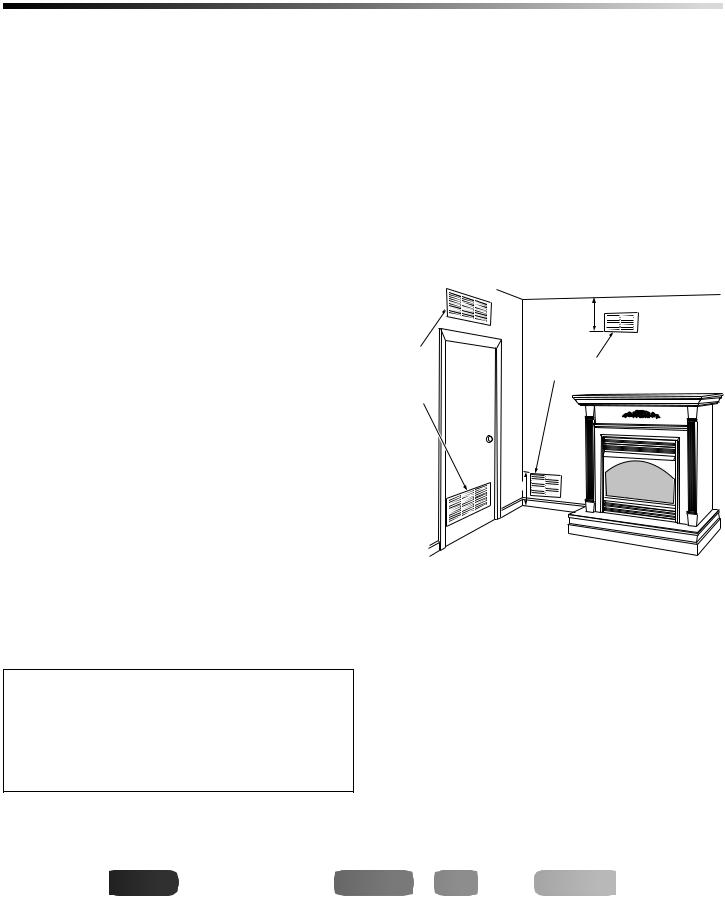
6 |
AIR FOR COMBUSTION AND VENTILATION |
Determining Fresh-Air Flow for Fireplace Location (Cont.) |
|
|
Ventilation Air |
|
|
AIR FOR COMBUSTION AND VENTILATION
Continued
3.Add the Btu/Hr of all fuel burning appliances in the space.
Vent-free fireplace |
|
_____________ Btu/Hr |
Gas water heater* |
|
_____________ Btu/Hr |
Gas furnace |
|
_____________ Btu/Hr |
Vented gas heater |
|
_____________ Btu/Hr |
Gas fireplace logs |
|
_____________ Btu/Hr |
Other gas appliances* + |
_____________ Btu/Hr |
|
Total |
= |
_____________ Btu/Hr |
* Do not include direct-vent gas appliances. Direct-vent draws combustion air from the outdoors and vents to the outdoors.
Example: |
|
|
Gas water heater |
|
30,000 |
|
_____________ Btu/Hr |
|
Vent-free fireplace |
+ |
10,000 |
_____________ Btu/Hr |
||
Total |
= |
40,000 |
_____________ Btu/Hr |
4.Compare the maximum Btu/Hr the space can support with the actual amount of Btu/Hr used.
__________________ Btu/Hr (maximum the space can support)
__________________ Btu/Hr (actual amount of Btu/Hr used)
Example: 35,840 Btu/Hr (maximum the space can support) 40,000 Btu/Hr (actual amount of Btu/Hr used)
The space in the above example is a confined space because the actual Btu/ Hr used is more than the maximum Btu/Hr the space can support. You must provide additional fresh air. Your options are as follows:
A.Rework worksheet, adding the space of an adjoining room. If the extra space provides an unconfined space, remove door to adjoining room or add ventilation grills between rooms. See Ventilation Air From
Inside Building.
B.Vent room directly to the outdoors. See Ventilation Air From Outdoors, page 7.
C.Install a lower Btu/Hr fireplace, if lower Btu/Hr size makes room unconfined.
If the actual Btu/Hr used is less than the maximum Btu/Hr the space can support, the space is an unconfined space. You will need no additional fresh air ventilation.
 WARNING: If the area in which the fireplace may be operated is smaller than that defined as an unconfined space or if the building is of unusually tight construction, provide adequate combustion and ventilation air by one of the methods described in the
WARNING: If the area in which the fireplace may be operated is smaller than that defined as an unconfined space or if the building is of unusually tight construction, provide adequate combustion and ventilation air by one of the methods described in the
National Fuel Gas Code, ANSI Z223.1/NFPA 54 Section 5.3 or applicable local codes.
VENTILATION AIR
Ventilation Air From Inside Building
This fresh air would come from an adjoining unconfined space. When ventilating to an adjoining unconfined space, you must provide two permanent openings: one within 12" of the ceiling and one within 12" of the floor on the wall connecting the two spaces (see options 1 and 2, Figure 4). You can also remove door into adjoining room (see option 3, Figure 4). Follow the National Fuel Gas Code, ANSI Z223.1/NFPA 54, Section 5.3, Air for Combustion and Ventilation for required size of ventilation grills or ducts.
|
|
12" |
|
Ventilation |
|
Ventilation Grills |
|
Grills |
|
||
Into Adjoining |
Or |
Into Adjoining Room, |
|
Room, |
Option 2 |
||
Remove |
|||
Option 1 |
|
||
Door into |
|
||
|
|
||
|
Adjoining |
|
|
|
Room, |
|
|
|
Option |
|
|
|
3 |
|
|
|
|
12" |
Figure 4 - Ventilation Air from Inside Building




 For
For





 visit
visit
 .
.

 .com
.com




111244-01A
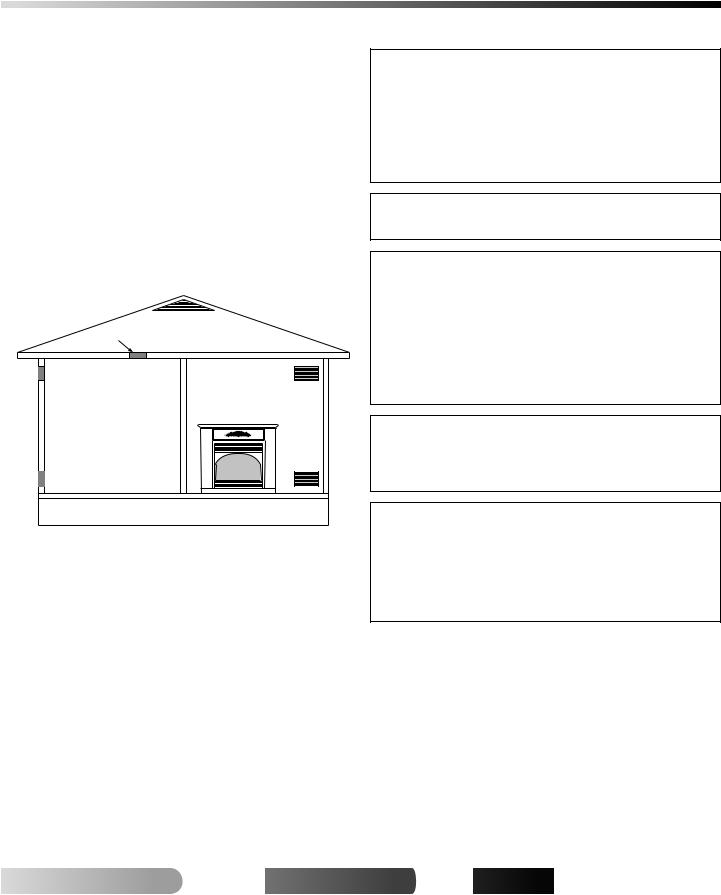
AIR FOR COMBUSTION AND VENTILATION INSTALLATION |
7 |
Ventilation Air (Cont.) |
|
INstallation |
|
|
|
AIR FOR COMBUSTION AND VENTILATION
Continued
Ventilation Air From Outdoors
Provide extra fresh air by using ventilation grills or ducts. You must provide two permanent openings: one within 12" of the ceiling and one within 12" of the floor. Connect these items directly to the outdoors or spaces open to the outdoors. These spaces include attics and crawl spaces. Follow the National Fuel Gas Code, ANSI Z223.1/NFPA 54, Section 5.3, Air for Combustion and Ventilation for required size of ventilation grills or ducts.
IMPORTANT: Do not provide openings for inlet or outlet air into attic if attic has a thermostat-controlled power vent. Heated air entering the attic will activate the power vent.
Ventilated
Outlet Attic
Air
Outlet 

Air
To Attic
To
Crawl
Space
Inlet
Air
|
|
Inlet Air |
|
Ventilated |
|
|
|
|
|
|
Crawl Space |
|
|
|
|
|
|
|
|
Figure 5 - Ventilation Air from Outdoors
INSTALLATION
NOTICE: This heater is intended for use as supplemental heat. Use this heater along with your primary heating system. Do not install this heater as your primary heat source. If you have a central heating system, you may run system’s circulating blower while using heater. This will help circulate the heat throughout the house. In the event of a power outage, you can use this heater as your primary heat source.
 WARNING: A qualified service person must install fireplace. Follow all local codes.
WARNING: A qualified service person must install fireplace. Follow all local codes.
 WARNING: Never install the fireplace
WARNING: Never install the fireplace
•in a bathroom
•in a recreational vehicle
•where curtains, furniture, clothing, or other flammable objects are less than 36 inches from the front, top, or sides of the fireplace
•as a fireplace insert
•in high traffic areas
•in windy or drafty areas
 WARNING: Never install the Remote-Ready Models in this manual in a bedroom. Any heating product with a Btu/hr rating over 10,000 cannot be used in a bedroom.
WARNING: Never install the Remote-Ready Models in this manual in a bedroom. Any heating product with a Btu/hr rating over 10,000 cannot be used in a bedroom.
 CAUTION: This fireplace creates warm air currents. These currents move heat to wall surfaces next to fireplace. Installing fireplace next to vinyl or cloth wall coverings or operating fireplace where impurities (such as, but not limited to, tobacco smoke, aromatic candles, cleaning fluids, oil or kerosene lamps, etc.) in the air exist, may discolor walls or cause odors.
CAUTION: This fireplace creates warm air currents. These currents move heat to wall surfaces next to fireplace. Installing fireplace next to vinyl or cloth wall coverings or operating fireplace where impurities (such as, but not limited to, tobacco smoke, aromatic candles, cleaning fluids, oil or kerosene lamps, etc.) in the air exist, may discolor walls or cause odors.
IMPORTANT: Vent-free fireplaces add moisture to the air. Although this is beneficial, installing fireplace in rooms without enough ventilation air may cause mildew to form from too much moisture. See Air for Combustion and Ventilation, pages 5 through 7.
Note: Your fireplace is designed to be used in zero clearance installations. Wall or framing material can be placed directly against any exterior surface on the rear, sides, or top of your fireplace, except where standoff spacers are integrally attached. If standoff spacers are attached to your fireplace, these spacers can be placed directly against wall or framing materials.
Note: When installing fireplace directly on carpeting, tile or other combustible material, other than wood flooring, the fireplace shall be installed on a metal or wood panel extending the full width and depth of the fireplace.
For more

 visit www.
visit www.

 .com
.com



111244-01A
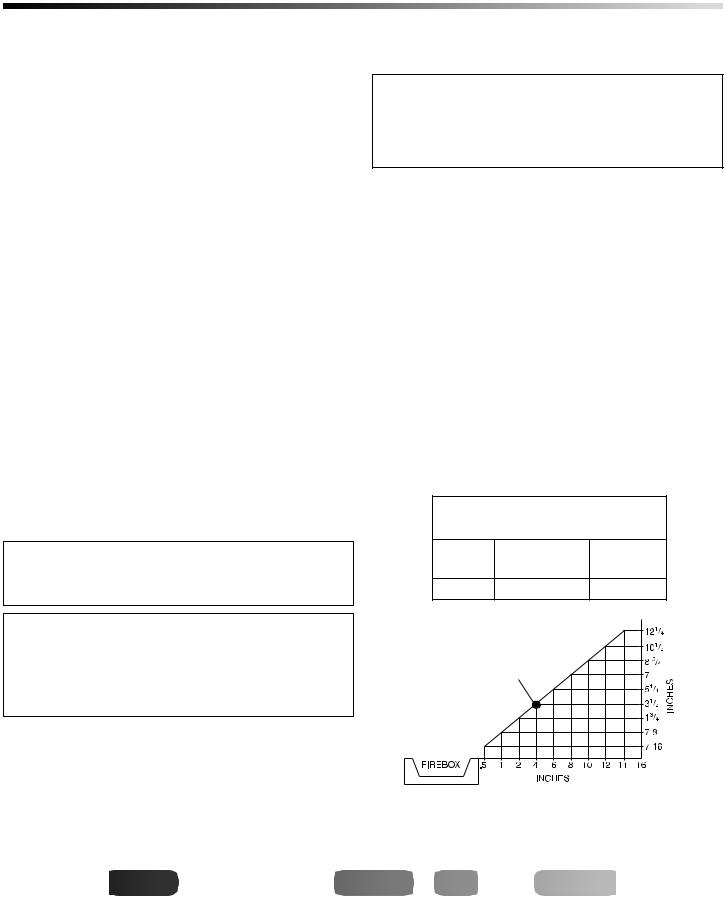
8 |
INSTALLATION |
Check Gas Type |
|
|
Installation Items |
|
Fireplace Clearances |
|
|
INSTALLATION
Continued
Use the dimensions shown for rough openings to create the easiest installation (see Built-In Fireplace Installation, page 9).
CHECK GAS TYPE
Use the correct gas type (natural or propane/LP) for your unit. If your gas supply is not correct, do not install fireplace. Call dealer where you bought fireplace for proper type fireplace.
INSTALLATION ITEMS
Before installing fireplace, make sure you have the items listed below.
•external regulator (supplied by installer, for propane/LP units only)
•piping (check local codes)
•sealant (resistant to propane/LP gas)
•equipment shutoff valve *
•test gauge connection*
•ground joint union
•sediment trap
•tee joint
•pipe wrench
* A CSA design-certified equipment shutoff valve with 1/8" NPT tap is an acceptable alternative to test gauge connection. Purchase the optional CSA design-certified equipment shutoff valve from your dealer. See Accessories, pages 36 and 37.
Note: If desired, purchase a four-sided brass trim kit for built-in installations. See Accessories, pages 36 and 37.
FIREPLACE CLEARANCES
 WARNING: Maintain the minimum clearances shown in Figure 6. If you can, provide greater clearances from floor, ceiling, and joining wall.
WARNING: Maintain the minimum clearances shown in Figure 6. If you can, provide greater clearances from floor, ceiling, and joining wall.
NOTICE: If you install the fireplace in a bedroom (Thermostat-Controlled Models only), some building codes require that the fireplace/mantel system be secured to (or within) a wall. You can position fireplace in an optional cabinet or corner mantel. You can also recess fireplace into the wall.
If your fireplace is to be used with an optional mantel, the installation instructions included with your mantel shows an CSA approved method of attaching the fireplace/mantel system to a wall. IMPORTANT: Only use optional cabinet or corner mantels specified in this manual. Purchase the optional mantel from your dealer (see Accessories, pages 36 and 37).
If your fireplace is to be recessed into the wall, see Built-In Fireplace Installation on page 9 to secure your fireplace into the wall.
 CAUTION: If you install the fireplace in a home garage
CAUTION: If you install the fireplace in a home garage
•fireplace pilot and burner must be at least 18 inches above floor.
•locate fireplace where moving vehicle will not hit it.
For convenience and efficiency, install fireplace
•where there is easy access for operation, inspection, and service
•in coldest part of room
An optional blower kit is available from your dealer. See Accessories, pages 36 and 37. If planning to use blower, follow instructions provided with blower for power source.
Minimum Clearances For Side Combustible
Material, Side Wall, and Ceiling
A.Clearances from the side of the fireplace cabinet to any combustible material and wall should follow diagram in Figure 6.
Example: The face of a mantel, bookshelf, etc. is made of combustible material and protrudes 3 1/2" from the wall. This combustible material must be 4" from the side of the fireplace opening (see Figure 6).
B.Clearances from the top of the fireplace opening to the ceiling should not be less than 36 inches.
C.For mantel clearances, see Figure 10 on page 10.
MINIMUM CLEARANCE TO
COMBUSTIBLE MATERIALS
Top |
Left and |
Bottom |
|
Right Sides |
and Rear |
36" |
6" |
0" |
|
Example |
|
|
|
* |
*Minimum 16 inches from Side Wall
Figure 6 - Minimum Clearance for Combustible to Wall




 For
For





 visit
visit
 .
.

 .com
.com




111244-01A
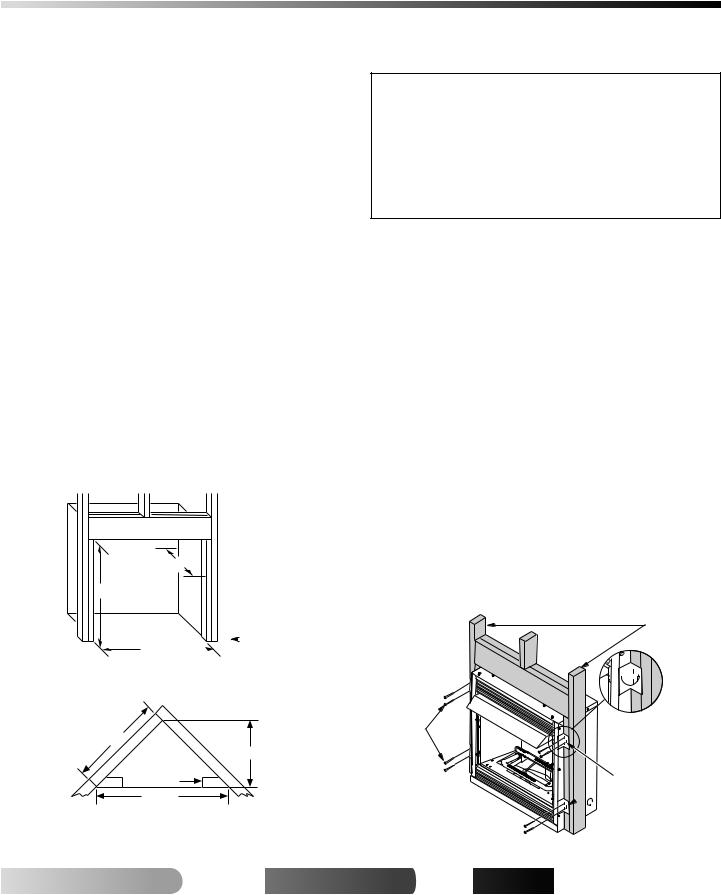
INSTALLATION |
9 |
Built-In Fireplace Installation |
|
|
|
INSTALLATION
Continued
BUILT-IN FIREPLACE INSTALLATION
Built-in installation of this fireplace involves installing fireplace into a framed-in enclosure. This makes the front of fireplace flush with wall. An optional brass trim kit accessory is available (see Accessories, pages 36 and 37). Brass trim will extend past sides of fireplace approximately 1/2 inch. This will cover the rough edges of the wall opening. If installing a built-in mantel above the fireplace, you must follow the clearances shown in Figure 10, page 10. Follow the instructions below to install the fireplace in this manner.
|
Actual |
Framing |
|
|
|
Height |
26" |
26 7/8" |
Front Width |
26 3/4" |
26 7/8" |
Depth |
14 1/4" |
15 1/4" |
1.Frame in rough opening. Use dimensions shown in Figure 7 for the rough opening. If installing in a corner, use dimensions shown in Figure 8 for the rough opening. The height is 26 7/8" which is the same as the wall opening above.
2.If installing GA3450TA blower accessory, do so at this time. Follow instructions included with blower accessory.
Note: If not installing blower accessory, you may wish to run electrical wiring to your fireplace for future blower installation (see Accessories, pages 36 and 37). Use only approved three-wire electrical wiring.
15 1/4"
267/8"
|
|
|
3/4" Off |
267/8" |
|
|
The Floor |
|
|
Minimum |
|
|
|
||
|
|
|
Figure 7 - Rough Opening for Installing in Wall
435/16"
305/8"
 267/8" 611/4"
267/8" 611/4"
Figure 8 - Rough Opening for Installing in Corner
 WARNING: If pre-wiring, do not connect wiring to any electrical source at this time.
WARNING: If pre-wiring, do not connect wiring to any electrical source at this time.
Install fireplace electrical outlet and connect wiring to outlet before connecting to electrical source. The fireplace electrical outlet is included with the GA3450TA blower accessory.
Only use the fireplace electrical outlet supplied with the GA3450TA blower accessory.
Note:A qualified installer should make all electrical connections.
3.Install gas piping to fireplace location. This installation includes an approved flexible gas line (if allowed by local codes) after the equipment shutoff valve. The flexible gas line must be the last item installed on the gas piping.
4.If you have not installed hood, follow instructions on page 4.
5.Carefully set fireplace in front of rough opening with back of fireplace inside wall opening.
6.Attach flexible gas line to fireplace gas regulator. See Connecting Equipment Shutoff Valve to Heater Control, page 15.
7.Bend four nailing flanges on outer casing with pliers (see Figure 9).
8.Attach fireplace to wall studs using nails or wood screws through holes in nailing flange.
9.Check all gas connections for leaks. See Checking Gas Connections, page 16.
10.If using optional brass trim kit, install the trim after final finishing and/or painting of wall. See instructions included with brass trim accessory for attaching brass trim.
IMPORTANT: When finishing your firebox, combustible materials such as wall board, gypsum board, sheet rock, drywall, plywood, etc. may be butted up next to the sides and top edge of the firebox. Combustible materials should never overlap the firebox front facing.
Wall Studs
Nails or
Wood
Screws
Nailing
 Flanges
Flanges
Figure 9 - Attaching Fireplace to Wall Studs
For more

 visit www.
visit www.

 .com
.com



111244-01A
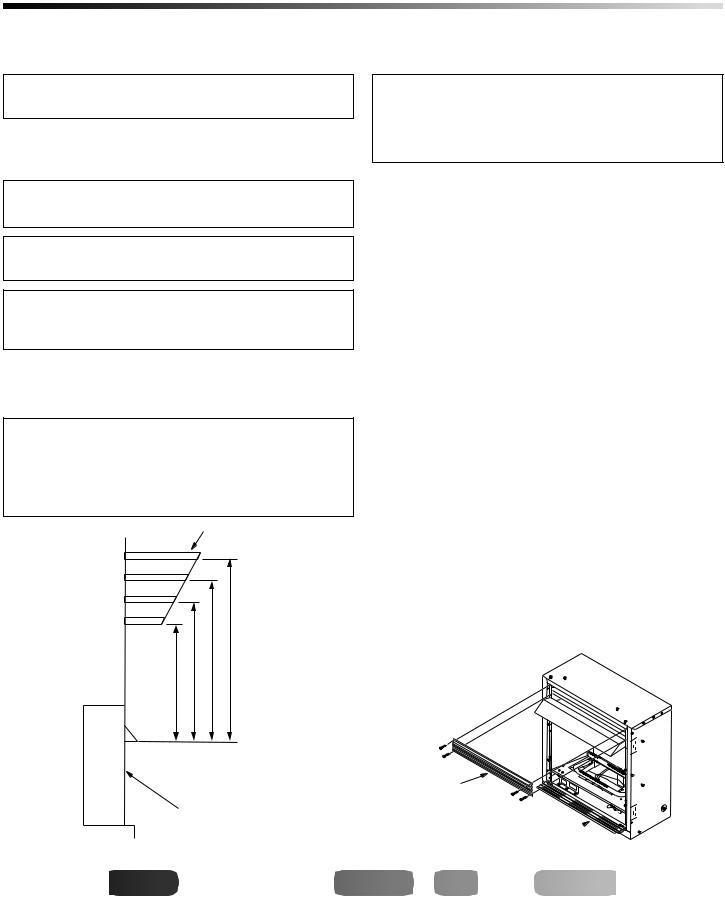
10 |
INSTALLATION |
Built-In Fireplace Installation (Cont.) |
|
|
Optional Mantel Installation |
|
|
INSTALLATION
Continued
 WARNING: Do not allow any combustible materials to overlap the firebox front facing.
WARNING: Do not allow any combustible materials to overlap the firebox front facing.
IMPORTANT: Noncombustible materials such as brick, tile, etc. may overlap the front facing, but should never cover any necessary openings like louvered slots.
NOTICE: If your installation does not meet the minimum clearances shown, you must do one of the following:
•raise the mantel to an acceptable height
•remove the mantel
 WARNING: Do not allow noncombustible materials to cover any necessary openings like louvered slots.
WARNING: Do not allow noncombustible materials to cover any necessary openings like louvered slots.
 WARNING: Never modify or cover the louvered slots on the front of the firebox.
WARNING: Never modify or cover the louvered slots on the front of the firebox.
 WARNING: Use only noncombustible mortar or adhesives when overlapping the front facing with noncombustible facing material.
WARNING: Use only noncombustible mortar or adhesives when overlapping the front facing with noncombustible facing material.
Mantel Clearances for Built-In Installation
If placing mantel above built-in fireplace, you must meet minimum clearance between mantel shelf and top of fireplace opening.
NOTICE: Surface temperatures of adjacent walls and mantels become hot during operation. Walls and mantels above the firebox may become hot to the touch. If installed properly, these temperatures meet the requirement of the national product standard. Follow all minimum clearances shown in this manual.
Mantel Shelf
Note: |
10" |
|
8" |
||
All vertical |
||
measurements |
6" |
|
are from top of |
||
2 1/2" |
||
fireplace |
opening to bottom of mantel shelf. All measurements are in inches.
15" |
18" |
21" |
23" |
Side of Firebox
OPTIONAL MANTEL INSTALLATION
Note: Refer to instructions provided with the mantel for assembly instructions. Refer to the following instructions for system installation. Refer to instructions on page 4 for hood assembly. Blower accessory should be installed if it is being used (see Installing Optional Blower Accessory GA3450TA, pages 11 through 13).
1.Unscrew four screws that attach top louver to fireplace. Remove louver from fireplace and set aside (see Figure 11).
2.Place base assembly next to wall at installation location.
3.Place fireplace on wood base (see Figure 12, page 11).
4.Place mantel around fireplace on base (see Figure 12, page 11).
5.Assemble perimeter trim kit. See Assembling Perimeter Trim, page 11.
6.Firmly snap perimeter trim kit on shoulder screws. Shoulder screws are located on fireplace cabinet (see Figure 12, page 11).
7.Align perimeter trim kit for flush fit around opening.
8.Center mantel left to right on base making sure mantel is flush against wall.
9.Use two 3" wood screws provided and attach base of fireplace to wooden mantel base (see Figure 12, page 11).
10.Remove perimeter trim kit and mantel. Be careful not to damage wall or mantel.
11.Cut an access hole in base to run flexible gas line to fireplace (see Figure 12, page 11). Make sure to locate access hole so mantel will cover it when installed. Note: You can secure base to floor using wood screws. Countersink screw heads and putty over.
12.Install gas line. See Connecting To Gas Supply, pages 14 and 15.
Top Louver
Bottom Louver 
Figure 10 - Minimum Mantel Clearances for Built-In Installation |
Figure 11 - Removing Top Louver and Opening Bottom Louver |
|




 For
For





 visit
visit
 .
.

 .com
.com




111244-01A
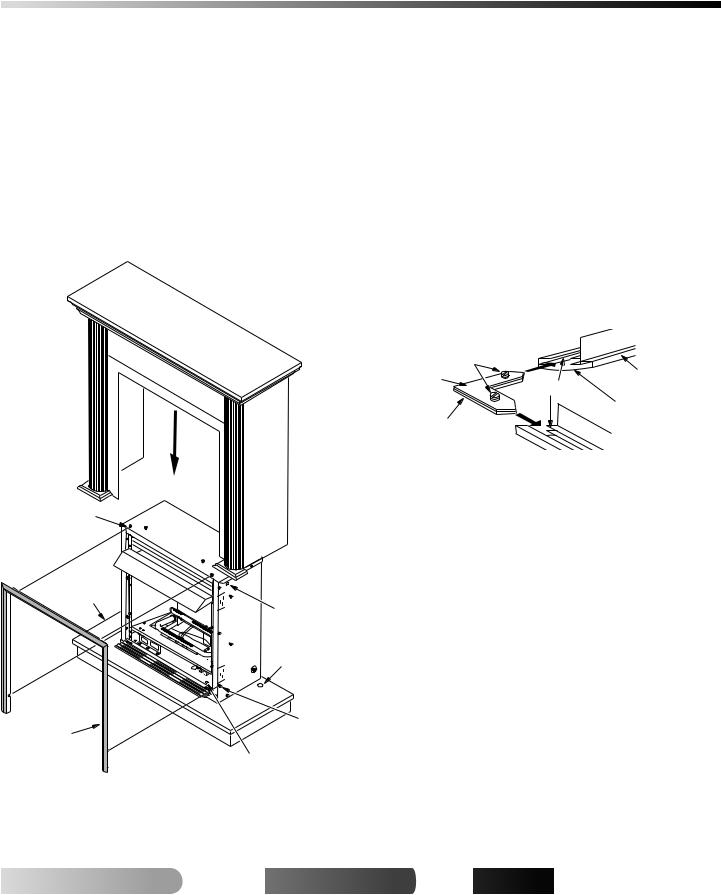
INSTALLATION |
11 |
Optional Mantel Installation (Cont.) |
|
Installing Optioanl Blower Accessory GA3450TA |
|
|
|
INSTALLATION
Continued
13.Check for leaks. See Checking Gas Connections, page 16.
14.Place mantel around fireplace. Be careful not to damage wall or mantel.
15.Place perimeter trim kit on the shoulder screws located on the side and top of the fireplace. Firmly snap trim over shoulder screws on fireplace (see Figure 12).
16.Adjust assembly to remove any gaps. Attach remaining two 3" wood screws from hardware pack through openings inside of fireplace sides into the mantel. The openings are located at top behind the area for top louver (see Figure 12).
17.Reinstall top louver.
Shoulder Screw
Mantel
Base
Assembled
Brass Trim
Hole for 3" Wood Screw for Attaching Fireplace to Mantel
Gas Line
Access Hole
Shoulder
Screws
Hole for 3" Wood Screw for Attaching Fireplace to Wooden Base
Figure 12 - Attaching Brass Trim to Fireplace
Assembling Perimeter Trim (Perimeter trim shipped with mantel)
1.Remove packaging from three remaining pieces of trim.
2.Locate two adjusting plates with set screws, and two shims in the hardware packet.
3.Align shim under adjusting plate as shown in Figure 13.
4.Slide one end of adjusting plate/shim in slot on mitered edge of top brass trim (see Figure 13).
5.Slide other end of adjusting plate/shim in slot on mitered edge of side perimeter trim (see Figure 13).
6.While firmly holding edges of perimeter trim together, tighten both set screws on the adjusting plate with slotted screwdriver.
7.Repeat steps 1 through 6 for other corner.
8.Set perimeter trim assembly aside for later installation.
Set
Screws
Adjusting |
Top Brass Trim |
Plate |
Slot |
|
Mitered Edge |
Shim |
|
Side Brass Trim 
Figure 13 - Assembling Brass Trim
INSTALLING OPTIONAL BLOWER ACCESSORY GA3450TA
Removing Upper Louver
To install the blower accessory, you must first remove the upper louver.
1.Lift screen off fireplace and remove log set if installed.
2.Remove 4 screws from upper louver (see Figure 11, page 10). Save these screws.
3.Pull upper louver straight out from the cabinet. Be careful not to scratch the paint. Set louver aside.
4.Open lower louver door by swinging door down (see Figure 11, page 10).
For more

 visit www.
visit www.

 .com
.com



111244-01A

INSTALLATION
12 Installing Optional Blower Accessory GA3450TA (Cont.)
INSTALLATION
Continued
Installing Blower Accessory
 CAUTION: Label all wires prior to disconnection when servicing controls. Wiring errors can cause improper and dangerous operation.
CAUTION: Label all wires prior to disconnection when servicing controls. Wiring errors can cause improper and dangerous operation.
 CAUTION: Verify proper operation after servicing.
CAUTION: Verify proper operation after servicing.
Note: If you are using a mantel with your fireplace, use the following instructions. If your fireplace is built-in, see For Built-In Installation, page 13.
1.Install snap bushings found in blower kit into hole in left side of outer casing and into one of the holes in rear of remote/ blower bracket.
2.Make sure the wire harness is firmly connected to the terminals on the blower bracket assembly.
3.Note the wire locations on back of AUTO/OFF/ON switch. The terminals on back of switch are numbered 1, 2, and 3. Carefully remove red wire from terminal 3 and blue wire from terminal 1. Black wire can remain on middle terminal 2 (see Figure 14).
4.Carefully disconnect green and white wires at their insulated connectors (see Figure 15).
|
Wire |
Wiring Routing |
|
Blower Bracket |
Hole in Baffle |
|
|
Assembly |
Harness |
Baffle |
Blower |
|
|
||
Screw |
|
|
Mounting |
|
|
Holes |
Switch
Power Cord
3 2 1
Blue |
|
|
Black |
|
|
Switch |
Red |
Wire Harness |
|
||
Plate |
|
|
|
|
|
Remote/Blower
Bracket Lower Louver Door
Figure 14 - Installing Blower Bracket Assembly (Remote-Ready
Unit Shown)
5.In top of the fireplace cabinet, locate the four mounting holes on the outer casing. Align these four holes with those on the blower bracket assembly. Attach blower bracket assembly to the outer casing with 4 #10 screws provided (see Figure 14).
6.Route the wire harness through the hole in left side of baffle and between firebox wrapper and outer casing.
7.Insert the 4 wire harnesses from behind the remote/blower bracket through hole in rear of bracket with bushing and through the left rectangular hole to front of fireplace (see Figure 14).
8.Reconnect red wire to switch position 3. Reconnect blue wire to switch position 1. Reconnect green and white wires.
9.Install the switch plate on the remote/blower bracket with 2 #10 screws provided (see Figure 16). Route power cord out of the cabinet by inserting it through the bushing on the outer casing (see Figure 14). Plug fan kit into 120-Volt grounded power supply and test operation. Note: When switch is in the AUTO position, the fan will start after the fireplace has run for a few moments. The fan will continue to run for several moments after the fireplace has been turned off. When switch is in the ON position, the fan will run until turned to OFF.
10.Reinstall upper louver beginning with bottom screws (see Figure 11, page 10). Close lower louver door.
|
|
Fan Switch |
|
|||
|
|
(Auto/Off/On) |
|
|||
|
|
|
1 Auto |
|
||
|
|
Off |
2 |
|
|
|
|
|
|
3 |
Blue |
Thermostat |
|
|
|
|
|
|
||
|
|
|
On |
|
Switch |
|
|
|
|
|
(N.O.) |
||
|
|
|
|
|
|
Blue |
110/115 |
Red |
Blower |
||||
|
V.A.C. |
|
|
|
Motor |
|
|
|
Black |
|
|
|
Red |
|
|
|
|
|
||
|
|
|
|
|
|
|
|
|
White |
|
|
|
White |
|
|
Green |
|
|
|
Green |
Figure 15 - Wiring Diagram For Blower Accessory Standard
Installation
Remote/Blower
Bracket
Switch 
Plate
Screw
Figure 16 - Installing Switch Plate to Remote/Blower Bracket




 For
For





 visit
visit
 .
.

 .com
.com




111244-01A
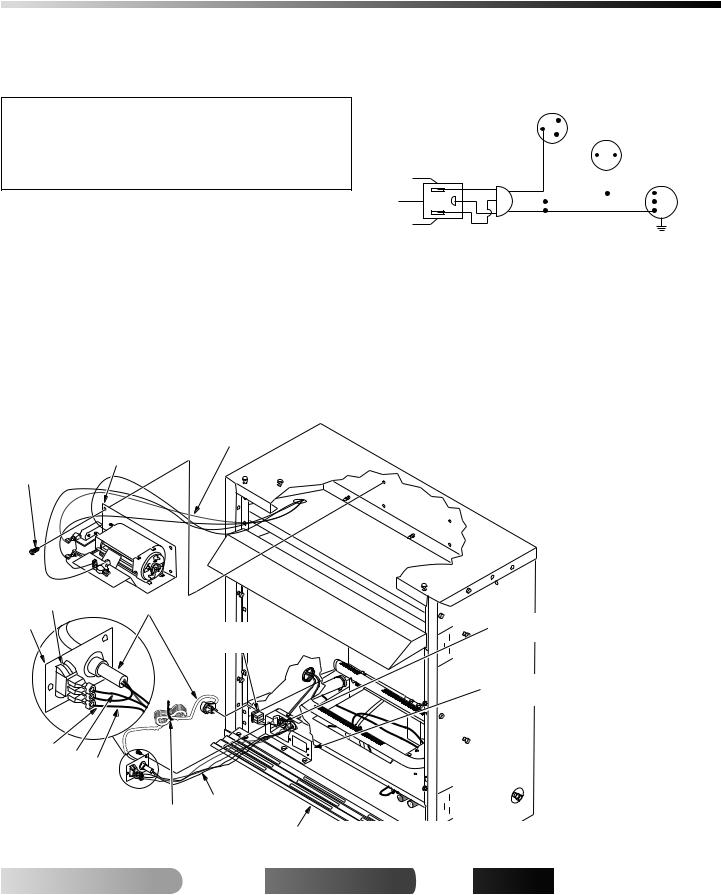
INSTALLATION |
13 |
Installing Blower Accessory GA3450TA (Cont.) |
|
|
|
INSTALLATION
Continued
For Built-In Installation
 WARNING: A licensed electrician must connect the wiring harness to electrical supply following all local codes.Electricianmustprovideaclampontheboxcover tosecurethewiring.Wiringshouldberoutedthroughthe bushing in the hole on the outer casing of fireplace.
WARNING: A licensed electrician must connect the wiring harness to electrical supply following all local codes.Electricianmustprovideaclampontheboxcover tosecurethewiring.Wiringshouldberoutedthroughthe bushing in the hole on the outer casing of fireplace.
1.Install snap bushing from blower kit into one hole on rear of remote/blower bracket (see Figure 17). The other hole is for a strain relief clamp (not supplied) to secure incoming electrical supply.
2.Follow steps 2 through 6 in Installing Blower Accessory, page 12.
3.A licensed electrician must follow the wiring diagram to connect incoming electrical supply to fan kit wiring harness (see Figure 18).
4.Plug power cord to outlet receptacle (not provided) as shown in Figure 17. Wind extra cable of power cord and tie up with plastic wire strap (see Figure 17). Set cable bundle between the remote/blower bracket and outer casing, away from the burner.
5.Test to make sure blower is working properly.
6.Reinstall upper louver beginning with bottom screws (see Figure 11, page 10) and close lower louver.
|
Fan Switch |
|
|
|
|
|
|
||||
|
(Auto/Off/On) |
|
|
|
|
|
|
||||
|
|
1 Auto |
|
|
|
|
|
|
|||
|
Off |
2 |
|
|
|
|
|
|
|
|
|
|
|
3 |
Blue |
|
Thermostat |
||||||
|
|
|
On |
|
|
|
Switch |
||||
|
|
|
|
|
|
(N.O.) |
|||||
110/115 |
|
|
Red |
|
|
|
|
Blue |
|||
V.A.C. |
|
|
|
|
Blower |
||||||
|
Black |
|
|
|
|
|
|
|
|
Motor |
|
|
|
|
|
|
|
|
Red |
|
|||
|
White |
|
|
|
|
|
|
White |
|
||
|
Green |
|
|
|
|
|
|
Green |
|||
Figure 18 - Wiring Diagram For Blower Accessory Built-In
Installation
Extension Cord
Use extension cord if needed. The cord must have a three-prong, grounding plug and a three-hole receptacle. Make sure cord is in good shape. It must be heavy enough to carry the current needed. An undersized cord will cause a drop in line voltage. This will result in loss of power and overheating. Use a No. 16 AWG cord for lengths less than 50 feet.
Wire Harness
Blower Bracket
Assembly
Screw
|
Switch |
Power Cord |
Switch |
|
|
|
Outlet Receptacle |
|
Plate |
|
|
|
(not included) |
|
|
|
3 2 1
Blue Red
Black
Wire
Plastic Wire Harness
Strap
Lower Louver Door
Figure 17 - Installing Blower Bracket Assembly
I
H
N
O
Clamp Connector (not included)
Remote/ Blower
Bracket
O
F
F
For more

 visit www.
visit www.

 .com
.com



111244-01A
